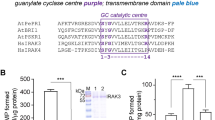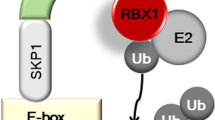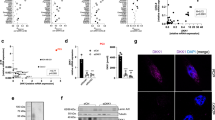Abstract
Interleukin (IL)-6-type cytokines such as IL-6, oncostatin M (OSM) and leukaemia inhibitory factor (LIF) signal through receptor complexes that are critically dependent on gp130. The latter is the common signal-transducing molecule that couples these cytokines to their downstream effectors, Janus kinases (JAKs) and signal transducers and activators of transcription (STATs). IL-6-type cytokine signalling additionally involves the recruitment and activation of extracellular signal-regulated kinase (ERK) 1 and ERK2. Both STATs and ERKs regulate responses mediated by members of the IL-6 family. Here, we show that ERK2, but not ERK1, also controls the expression and function of gp130 per se, as silencing ERK2 in human osteosarcoma U2OS cells inhibits the expression of gp130. This does not simply reflect quantitative differences between ERK1 and ERK2, and the effects are not restricted to osteosarcoma cells, as they can be extended to several other cancer cell types analysed to date (such as breast, prostate, lung and cervical cancer cells). Importantly, ERK2 binds to the GP130 promoter, where it perhaps interacts with the transcriptional machinery. Indeed, its role in the transcriptional regulation of the GP130 gene was corroborated using luciferase reporter assays and messenger RNA stability experiments. Considering the pivotal role that gp130 has in cancer and inflammation these data thus identify novel non-overlapping functions for ERK1 and ERK2 that are biologically relevant.
This is a preview of subscription content, access via your institution
Access options
Subscribe to this journal
Receive 50 print issues and online access
$259.00 per year
only $5.18 per issue
Buy this article
- Purchase on Springer Link
- Instant access to full article PDF
Prices may be subject to local taxes which are calculated during checkout







Similar content being viewed by others
References
Grivennikov SI, Karin M . Inflammatory cytokines in cancer: tumour necrosis factor and interleukin 6 take the stage. Ann Rheum Dis 2011; 70 (Suppl 1): i104–i108.
Yamanaka Y, Nakajima K, Fukada T, Hibi M, Hirano T . Differentiation and growth arrest signals are generated through the cytoplasmic region of gp130 that is essential for Stat3 activation. EMBO J 1996; 15: 1557–1565.
Neurath MF, Finotto S . IL-6 signaling in autoimmunity, chronic inflammation and inflammation-associated cancer. Cytokine Growth Factor Rev 2011; 22: 83–89.
Park EJ, Lee JH, Yu GY, He G, Ali SR, Holzer RG et al. Dietary and genetic obesity promote liver inflammation and tumorigenesis by enhancing IL-6 and TNF expression. Cell 2010; 140: 197–208.
Bromberg J, Wang TC . Inflammation and cancer: IL-6 and STAT3 complete the link. Cancer Cell 2009; 15: 79–80.
Yu H, Jove R . The STATs of cancer—new molecular targets come of age. Nat Rev Cancer 2004; 4: 97–105.
Song L, Turkson J, Karras JG, Jove R, Haura EB . Activation of Stat3 by receptor tyrosine kinases and cytokines regulates survival in human non-small cell carcinoma cells. Oncogene 2003; 22: 4150–4165.
Koskela HL, Eldfors S, Ellonen P, van Adrichem AJ, Kuusanmaki H, Andersson EI et al. Somatic STAT3 mutations in large granular lymphocytic leukemia. N Engl J Med 2012; 366: 1905–1913.
Inda MM, Bonavia R, Mukasa A, Narita Y, Sah DW, Vandenberg S et al. Tumor heterogeneity is an active process maintained by a mutant EGFR-induced cytokine circuit in glioblastoma. Genes Dev 2010; 24: 1731–1745.
Gough DJ, Corlett A, Schlessinger K, Wegrzyn J, Larner AC, Levy DE . Mitochondrial STAT3 supports Ras-dependent oncogenic transformation. Science 2009; 324: 1713–1716.
Inghirami G, Chiarle R, Simmons WJ, Piva R, Schlessinger K, Levy DE . New and old functions of STAT3: a pivotal target for individualized treatment of cancer. Cell Cycle 2005; 4: 1131–1133.
Schlessinger K, Levy DE . Malignant transformation but not normal cell growth depends on signal transducer and activator of transcription 3. Cancer Res 2005; 65: 5828–5834.
Santos CI, Costa-Pereira AP . Signal transducers and activators of transcription-from cytokine signalling to cancer biology. Biochim Biophys Acta 2011; 1816: 38–49.
Heinrich PC, Behrmann I, Haan S, Hermanns HM, Muller-Newen G, Schaper F . Principles of interleukin (IL)-6-type cytokine signalling and its regulation. Biochem J 2003; 374: 1–20.
Bromberg JF, Wrzeszczynska MH, Devgan G, Zhao Y, Pestell RG, Albanese C et al. Stat3 as an oncogene. Cell 1999; 98: 295–303.
Yu H, Pardoll D, Jove R . STATs in cancer inflammation and immunity: a leading role for STAT3. Nat Rev Cancer 2009; 9: 798–809.
Kamimura D, Ishihara K, Hirano T . IL-6 signal transduction and its physiological roles: the signal orchestration model. Rev Physiol Biochem Pharmacol 2003; 149: 1–38.
Costa-Pereira AP, Bonito NA, Seckl MJ . Dysregulation of Janus kinases and signal transducers and activators of transcription in cancer. Am J Cancer Res 2011; 1: 806–816.
Ernst M, Jenkins BJ . Acquiring signalling specificity from the cytokine receptor gp130. Trends Genet 2004; 20: 23–32.
Hermanns HM, Radtke S, Schaper F, Heinrich PC, Behrmann I . Non-redundant signal transduction of interleukin-6-type cytokines. The adapter protein Shc is specifically recruited to rhe oncostatin M receptor. J Biol Chem 2000; 275: 40742–40748.
Schiemann WP, Bartoe JL, Nathanson NM . Box 3-independent signaling mechanisms are involved in leukemia inhibitory factor receptor alpha- and gp130-mediated stimulation of mitogen-activated protein kinase. Evidence for participation of multiple signaling pathways which converge at Ras. J Biol Chem 1997; 272: 16631–16636.
Fukada T, Hibi M, Yamanaka Y, Takahashi-Tezuka M, Fujitani Y, Yamaguchi T et al. Two signals are necessary for cell proliferation induced by a cytokine receptor gp130: involvement of STAT3 in anti-apoptosis. Immunity 1996; 5: 449–460.
Stuhlmann-Laeisz C, Lang S, Chalaris A, Krzysztof P, Enge S, Eichler J et al. Forced dimerization of gp130 leads to constitutive STAT3 activation, cytokine-independent growth, and blockade of differentiation of embryonic stem cells. Mol Biol Cell 2006; 17: 2986–2995.
Rebouissou S, Amessou M, Couchy G, Poussin K, Imbeaud S, Pilati C et al. Frequent in-frame somatic deletions activate gp130 in inflammatory hepatocellular tumours. Nature 2009; 457: 200–204.
Yoshimura A . Signal transduction of inflammatory cytokines and tumor development. Cancer Sci 2006; 97: 439–447.
Hirai H, Karian P, Kikyo N . Regulation of embryonic stem cell self-renewal and pluripotency by leukaemia inhibitory factor. Biochem J 2011; 438: 11–23.
Lefloch R, Pouyssegur J, Lenormand P . Single and combined silencing of ERK1 and ERK2 reveals their positive contribution to growth signaling depending on their expression levels. Mol Cell Biol 2008; 28: 511–527.
Saba-El-Leil MK, Vella FD, Vernay B, Voisin L, Chen L, Labrecque N et al. An essential function of the mitogen-activated protein kinase Erk2 in mouse trophoblast development. EMBO reports 2003; 4: 964–968.
Pages G, Guerin S, Grall D, Bonino F, Smith A, Anjuere F et al. Defective thymocyte maturation in p44 MAP kinase (Erk 1) knockout mice. Science 1999; 286: 1374–1377.
Bourcier C, Jacquel A, Hess J, Peyrottes I, Angel P, Hofman P et al. p44 mitogen-activated protein kinase (extracellular signal-regulated kinase 1)-dependent signaling contributes to epithelial skin carcinogenesis. Cancer Res 2006; 66: 2700–2707.
Rodriguez J, Crespo P . Working without kinase activity: phosphotransfer-independent functions of extracellular signal-regulated kinases. Sci Signal 2011; 4: re3.
Voisin L, Saba-El-Leil MK, Julien C, Fremin C, Meloche S . Genetic demonstration of a redundant role of extracellular signal-regulated kinase 1 (ERK1) and ERK2 mitogen-activated protein kinases in promoting fibroblast proliferation. Mol Cell Biol 2010; 30: 2918–2932.
Roux PP, Blenis J . ERK and p38 MAPK-activated protein kinases: a family of protein kinases with diverse biological functions. Microbiol Mol Biol Rev 2004; 68: 320–344.
Mebratu Y, Tesfaigzi Y . How ERK1/2 activation controls cell proliferation and cell death: Is subcellular localization the answer? Cell Cycle 2009; 8: 1168–1175.
Pouyssegur J, Lenormand P . Fidelity and spatio-temporal control in MAP kinase (ERKs) signalling. Eur J Biochem 2003; 270: 3291–3299.
Chen Z, Gibson TB, Robinson F, Silvestro L, Pearson G, Xu B et al. MAP kinases. Chem Rev 2001; 101: 2449–2476.
Vantaggiato C, Formentini I, Bondanza A, Bonini C, Naldini L, Brambilla R . ERK1 and ERK2 mitogen-activated protein kinases affect Ras-dependent cell signaling differentially. J Biol 2006; 5: 14.
Lavagni P, Indrigo M, Colombo G, Martegani E, Rosenblum K, Gnesutta N et al. Identification of novel RasGRF1 interacting partners by large-scale proteomic analysis. J Mol Neurosci 2009; 37: 212–224.
Shin S, Dimitri CA, Yoon SO, Dowdle W, Blenis J . ERK2 but not ERK1 induces epithelial-to-mesenchymal transformation via DEF motif-dependent signaling events. Mol Cell 2010; 38: 114–127.
Krens SF, Corredor-Adamez M, He S, Snaar-Jagalska BE, Spaink HP . ERK1 and ERK2 MAPK are key regulators of distinct gene sets in zebrafish embryogenesis. BMC Genomics 2008; 9: 196.
Marchi M, D'Antoni A, Formentini I, Parra R, Brambilla R, Ratto GM et al. The N-terminal domain of ERK1 accounts for the functional differences with ERK2. PLoS One 2008; 3: e3873.
Hu S, Xie Z, Onishi A, Yu X, Jiang L, Lin J et al. Profiling the human protein-DNA interactome reveals ERK2 as a transcriptional repressor of interferon signaling. Cell 2009; 139: 610–622.
Cohen-Armon M, Visochek L, Rozensal D, Kalal A, Geistrikh I, Klein R et al. DNA-independent PARP-1 activation by phosphorylated ERK2 increases Elk1 activity: a link to histone acetylation. Mol Cell 2007; 25: 297–308.
Shapiro PS, Whalen AM, Tolwinski NS, Wilsbacher J, Froelich-Ammon SJ, Garcia M et al. Extracellular signal-regulated kinase activates topoisomerase IIalpha through a mechanism independent of phosphorylation. Mol Cell Biol 1999; 19: 3551–3560.
Roy SK, Hu J, Meng Q, Xia Y, Shapiro PS, Reddy SP et al. MEKK1 plays a critical role in activating the transcription factor C/EBP-beta-dependent gene expression in response to IFN-gamma. Proc Natl Acad Sci USA 2002; 99: 7945–7950.
O'Brien CA, Manolagas SC . Isolation and characterization of the human gp130 promoter. Regulation by STATS. J Biol Chem 1997; 272: 15003–15010.
Jain N, Zhang T, Fong SL, Lim CP, Cao X . Repression of Stat3 activity by activation of mitogen-activated protein kinase (MAPK). Oncogene 1998; 17: 3157–3167.
Pokholok DK, Zeitlinger J, Hannett NM, Reynolds DB, Young RA . Activated signal transduction kinases frequently occupy target genes. Science 2006; 313: 533–536.
Fasnacht N, Muller W . Conditional gp130 deficient mouse mutants. Semin Cell Dev Biol 2008; 19: 379–384.
Radtke S, Wuller S, Yang XP, Lippok BE, Mutze B, Mais C et al. Cross-regulation of cytokine signalling: pro-inflammatory cytokines restrict IL-6 signalling through receptor internalisation and degradation. J Cell Sci 2010; 123: 947–959.
Marchetti A, Cecchinelli B, D'Angelo M, D'Orazi G, Crescenzi M, Sacchi A et al. p53 can inhibit cell proliferation through caspase-mediated cleavage of ERK2/MAPK. Cell Death Differ 2004; 11: 596–607.
Watling D, Carmo CR, Kerr IM, Costa-Pereira AP . Multiple kinases in the interferon-gamma response. Proc Natl Acad Sci USA 2008; 105: 6051–6056.
Pfaffl MW . A new mathematical model for relative quantification in real-time RT-PCR. Nucleic Acids Res 2001; 29: e45.
Acknowledgements
We are grateful to Dr Charles A O’Brien (University of Arkansas for Medical Sciences, Little Rock, USA) for control and full-length gp130 (p2433) luciferase constructs. Within Imperial College London, the authors are indebted to Dr Charlotte Bevan and her research team, Dr Rajat Roy, Mr Richard Schlegel and Dr Olivier Pardo for many helpful discussions, and Dr Anna Maria Tommasi for technical help. NB is funded by a PhD studentship (SFRH/BD/61857/2009) from the Foundation for Science and Technology (FCT) (Lisbon, Portugal), and CRC is funded by Cancer Treatment and Research Trust (CTRT). APC-P and MJS are funded by Cancer Research UK and CTRT. JD and HMH are funded by the Deutsche Forschungsgemeinschaft (DFG, FZ82). APC-P is also the recipient of an Elsie Widdowson Fellowship.
Author Contributions
APC-P designed the study and wrote the manuscript; NB, JD, SS, CRC, HMH have conducted the experiments; all authors have analysed the data and commented on the manuscript.
Disclaimer
The funders had no role in study design, data collection and analysis, decision to publish, or preparation of the manuscript.
Author information
Authors and Affiliations
Corresponding author
Ethics declarations
Competing interests
The authors declare no conflict of interest.
Additional information
Supplementary Information accompanies this paper on the Oncogene website
Rights and permissions
About this article
Cite this article
Bonito, N., Drechsler, J., Stoecker, S. et al. Control of gp130 expression by the mitogen-activated protein kinase ERK2. Oncogene 33, 2255–2263 (2014). https://doi.org/10.1038/onc.2013.159
Received:
Revised:
Accepted:
Published:
Issue Date:
DOI: https://doi.org/10.1038/onc.2013.159
Keywords
This article is cited by
-
BRAF status modulates Interelukin-8 expression through a CHOP-dependent mechanism in colorectal cancer
Communications Biology (2020)
-
Erk2 but not Erk1 regulates crosstalk between Met and EGFR in squamous cell carcinoma cell lines
Molecular Cancer (2015)
-
DAPK2 regulates oxidative stress in cancer cells by preserving mitochondrial function
Cell Death & Disease (2015)
-
DAPK2 is a novel modulator of TRAIL-induced apoptosis
Cell Death & Differentiation (2014)



